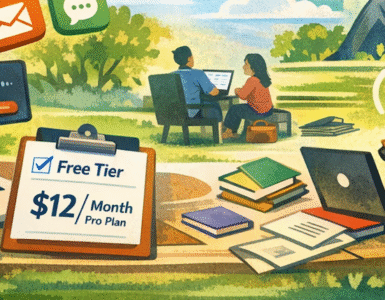by Ly Lutter, Osnabrück University, Germany.
How can we best support teaching staff in implementing media-rich teaching and learning? And how can we use teaching material for on-site classes in hybrid settings meaningfully?
Our answer is the Teaching Toolbox — a website that is focused on improving “weak spots” in existing teaching material and that connects learning scenarios with step-by-step guides, tool suggestions, testimonials, and more.
Why we created the Teaching Toolbox
Born out of the OS-COSMOS pilot project, our toolbox emerged from the need to transform courses quickly with minimal effort to online and asynchronous teaching. Initially, our team, consisting of two subject matter experts, an educationalist, and a small group of student assistants, handled the digital transformation. But we soon realised instructors needed a self-help tool for ongoing support.
Understanding the “Weak Spots”
Instructors were often uncertain about rules when using digital tools, inexperienced with media-rich education, and hesitant to spend hours on redesigning their classes for hybrid settings. However, the courses’ strengths didn’t work in hybrid settings. So how could we use the existing material in a meaningful way in hybrid settings without carrying over didactical “weak spots”?
We saw that successful transformation required support that is:
1. Digital, free, and easily accessible.
2. Simple to use, with clear guidance for digital beginners.
3. Professional, yet discreet in offering advice current teaching practices.
4. Clearly relevant and making change enticing and simple.
Turning the “Weak Spots” into Didactical Building Blocks
These principles were the starting point for the development of our teaching toolbox website. It became a digital guide focusing on adjusting existing materials for hybrid settings through didactical building blocks based on the “weak spots” we identified earlier.
These didactical building blocks address essential aspects that can be weak in hybrid settings: Human Touch, Student Engagement, Discussion, well-designed and clear Assignments, Accessible and Adjusted Teaching Material, Assessments, and Organization.

Teaching Toolbox landing page with an overview of the eight didactical building blocks.
Building the Toolbox
Since instructors often have little time for didactical preparation, we made sure the Teaching Toolbox provides only brief, essential information about building blocks and their importance in class, along with references for deeper exploration. Each building block includes four practical teaching tips to target the specific “weak spot.” These tips offer:
- Suggestions on use cases
- Recommended tools
- Estimations of teacher effort
- Step-by-step implementation guides
- Supplementary materials and references
- A note field for sketching ideas

Content architecture of the Teaching Toolbox website
Streamlining course preparation with a personalised checklist
To organise course preparation, instructors can select teaching tips and they will be saved in a course checklist, categorised under the relevant didactical building blocks. This checklist remains visible on the left side of the screen, ensuring helpful ideas stay organised and easily accessible. It tracks which building blocks were addressed and keeps course preparation organised.

Building block page of the Teaching Toolbox Example of a teaching tip page.
GDPR-compliant tools for your LMS
We recommend only GDPR-compliant tools that integrate smoothly with Stud.IP, our local LMS, so our instructors don’t have to double check the regulations and rules that apply when using a specific tool and can get support from our support center.
But what if your institution doesn’t use Stud.IP? What if you need different suggestions for digital tools, or would even like add or modify content of the website to fit your needs? No problem.
Customisation and Contributions
Our Toolbox website is licensed under an AGPL license. This means you can customise both content and software architecture to fit your needs, as long as you share your modifications with the community. To modify or add new content (like Building Blocks or Teaching Tips), simply:
- Create or adjust content in a JSON5 file format.
- Update the JSON5 representations of the Building Blocks or Teaching Tips.
- Integrate changes into the Django Application.
For software contributions, visit our GitHub page. We’re happy to review and integrate your enhancements, making them available to the entire Teaching Toolbox community.
Where can I find the Teaching Toolbox?
Explore the Teaching Toolbox and check out the Toolbox GitHub repository.

Author
Ly Lutter, M. Sc. Educational Science and Technology, Osnabrück University, Germany














